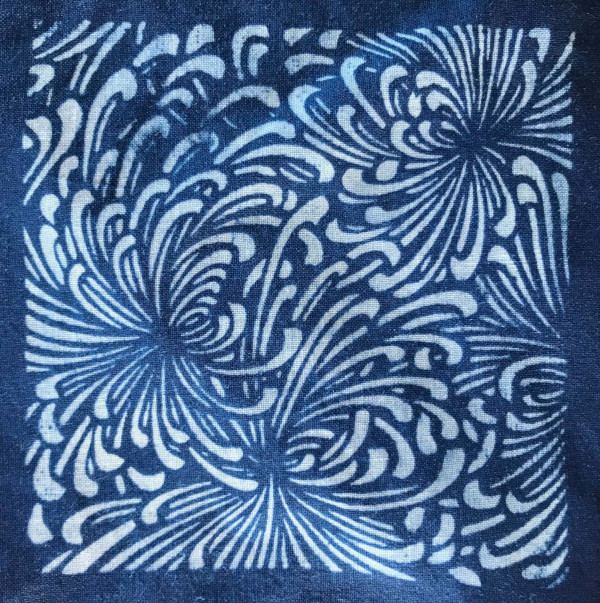
All Specialist Materials to be paid for on the day for an Additional £20
This course is restricted to a maximum of 10 participants

The Japanese crafts of Katagami (stencil cutting) and Katazome (dyeing using stencils) are ancient ones in Japan, with craftspeople making the most delicate and detailed patterns and representations of nature and Japanese life on fabric. Katagami stencils are made from handmade Japanese washi (Mulberry) paper,soaked and bonded together using the 5 years aged juice of the Persimmon fruit (Kakishibu) and then dried and smoked to create an almost entirely waterproof paper, ideal for stencil work.
Katagami/Katazome stencilling
On the first day you will use your own design to cut a simple paper stencil using Kakishibugami stencil paper provided by the tutor. The design needs to fit into a 10cm square. You will learn how to make and apply the traditional rice paste used as a resist and
start to use the tutor’s modern and vintage Japanese stencils using indigo dye. The tutor will explain how to set up and maintain an indigo vat for dyeing your work.
On the second day you can use your own cut stencil and practise pattern matching with the tutor’s stencils to create larger patterns as would have been traditional in Japan. There will also be time to experiment with overlaying one stencil over another to create different effects.
Your tutor will also explain about the history of Katagami stencilling in Japan, the four types of stencil cutting techniques, and show you his collection of vintage stencils. You should leave with the skills to cut and dye with your own stencils at home.
Rob travels to Japan annually for his practice and to stock up on the traditional Japanese stencilling supplies such as the Kakishibugami paper and Rice paste ingredients. These items are almost impossible to acquire outside Japan and for this reason are supplied to you directly by Rob at an additional cost of £20 (payment in cash only)
What you will need to bring
• Apron (note: indigo will stain if it gets on your clothes so ideally wear old
clothes/something you don’t mind getting a bit of dye on)
• Rubber gloves (these must be Marigolds or similar and cover the wrist)
• 3m Cotton/Linen/Bamboo or mixed natural plant-based fabrics (these must be
scoured or pre-washed or bought PFD to ensure they do not contain any
preserving chemicals as this impedes the uptake of the indigo dye)
The best fabric would be a shirting or quilting cotton but old cotton sheets
from the charity shop are a cheaper alternative.
Very heavy or very fine fabrics (such as cotton lawn) are not suitable.
• Ruler/drawing materials/Tracing paper
• Glue stick
• Hairdryer (some will be available to use)
• Notepad/camera (if you wish to record their work)
• Several designs for their stencil (you will receive an email with details about
this with links to places to go for inspiration)
